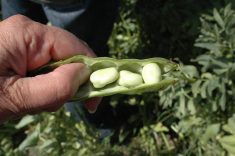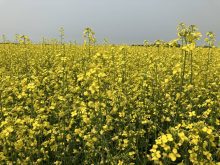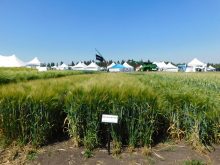saskatoon
Proposed changes to wheat classifications would increase Canada’s ability to compete with American winter wheat in the international market, a discussion paper presented to the recent varietal registration meetings says.
Four “generic” winter wheat varieties might be moved to the new general-purpose class and a fifth be graded Canada Feed, according to a discussion paper prepared earlier this year by the Canadian Wheat Board (CWB) and Canadian Grain commission (CGC).
If the plan goes ahead, CDC Kestrel, CDC Clair, CDC Harrier and CDC Raptor would move to the Canada Western General Purpose (CWGP) class effective 2013. Farmers would be officially notified of the pending change Aug. 1, 2010 presumably giving them enough time to adopt newer, higher-quality winter wheats.
Read Also

New crop insurer policy enables easier startup for faba beans
Agriculture Financial Services Corporation updated its normals for faba beans, which may open the door for more Canadian producers to feel comfortable growing the pulse crop in the future.
Under the plan, CDC Falcon would automatically grade Canada Feed effective Aug. 1, 2013. However, if new high quality winter wheats suitable for Manitoba are not available, CDC Falcon’s change in status could be delayed, the discussion paper says.
In the early 1990s, recognizing Western farmers wanted higher-yielding red winter wheats with better disease resistance and superior winter survival, the Prairie Recommending Committee for Wheat, Rye and Triticale (PRCWRT) decided to support lower-quality varieties for registration in the CWRW class, according to the discussion paper.
In the mid-1990s, the CWB introduced the “select” category in the CWRW class to develop, promote and market superior-quality CWRW varieties for both domestic and offshore flour milling. In 1998, CWRW select varieties accounted for 10.3 per cent of total CWRW production. In 2009 select varieties accounted for 73.4 per cent of the class, the discussion paper says.
But there are big differences across the West. Select varieties make up 94 per cent of the winter wheats grown in Alberta, but just 31 per cent in Manitoba.
General purpose
The new Canada Western General Purpose (CWGP) wheat class was established Aug. 1. 2008. It’s designed for all types of high-yielding wheat best suited for livestock feed or ethanol production. Milling and baking quality isn’t measured or considered when new wheats destined for this call are being considered for registration.
Before the vote, Graham Worden, the CWB’s senior manager of technical services, said pulling the lower-quality generic winter wheat out of the CWRW class would improve the quality of winter wheat the CWB markets, increasing returns to farmers.
But Peter Entz, director of seed and traits for James Richardson International, noted generic winter wheat currently earns farmers more per bushel than general purpose wheat.
Brian Fowler, the University of Saskatchewan’s Crop Development Centre breeder who developed the varieties proposed for removal from the CWRW class, argued against it. “Generic” winter wheats have little impact on the class now and will have less as the varieties fade away, he said. The proposal is “a lot of fuss over a problem that the CWB should never have created in the first place,” he said.
In a written response Fowler wrote: “The primary objective of this proposal appears to be directed toward increasing the CWB control over CWRW wheat and restricting the future cultivar options available to farmers.”
Despite Fowler’s oral and written opposition, he seconded the PRCWRT’s motion to support the proposal and then voted in favour.
The deadline for responding to the discussion paper was March 5. The CGC and CWB will review responses over the next few weeks before announcing whether the proposal will be implemented, Worden said. [email protected]














